Results
Meet the Context
The project examines the cities of Santiago, Chile and Guadalajara, Mexico, focusing on
two cities comparable in population and size but with different crime rates.
We aim at defining operational guidelines to improve the security of walking for older people, providing results that can be significant for the promotion of walking in other Latin American settings.
Guadalajara
5.268.642 inhabitants
17% older people
10,04 homicides / 100.000 inh.
Santiago
6.160.040 inhabitants
11% older people
4,7 homicides / 100.000 inh
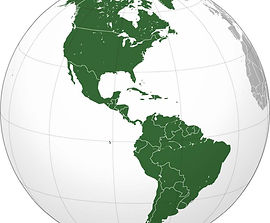
Preliminary Results
–
We propose to examine to what extent the occurrence of crime and perceived insecurity influence the possibility and the decision of older people to walk, focusing on Santiago, Chile and Guadalajara, Mexico.
Four crime indicators related to the number of destinations reached walking on the seven-day survey were calculated
Mexico’s neighbourhoods:
Santa Margarita (low registered crime)
Villaseñor (high registered crime).
Chile’s neighbourhoods
Peñalolen (low registered crime)
San Miguel (high registered crime)
1. Quantitative geospatial analysis
1. Ageing neighbourhoods in GDL and SCL
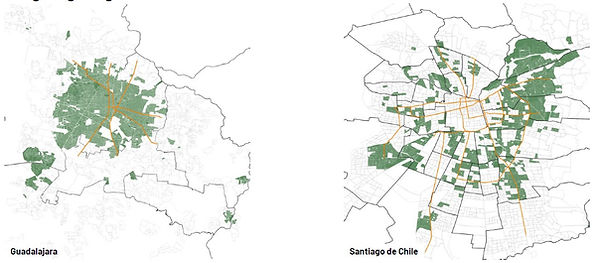
1. Ageing neighbourhoods, crime and local opportunities

Incivilities perception
Guadalajara
In Mexico, it is observed that more people walk in the neighborhood with the highest number of crime records despite the fact that there are also more incivilities perceived there than in the neighborhood with the lowest number of crime records.

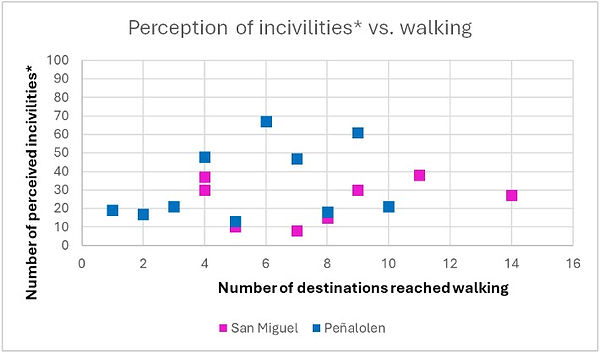
Santiago
In Chile, fewer perceived incivilities and more trips on foot are quantified. Surprisingly, in Chile, the neighborhood with the most security perceives more incivilities and walks less than the one with the least security.
Insecurity perception due to incivilities
Guadalajara
In Mexico, high-crime neighborhoods perceive greater insecurity in the face of incivilities and walk more, while no pattern is observed in low-crime neighborhoods, since they walk less, regardless of the perception of insecurity facing incivilities.
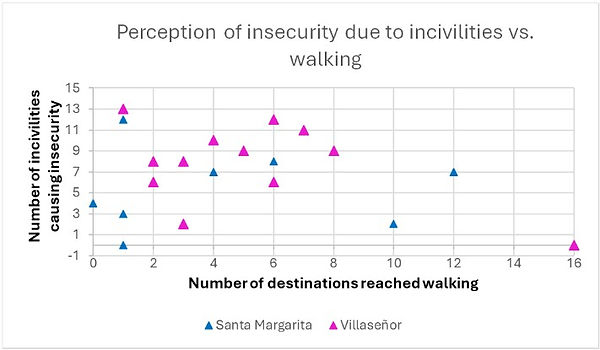
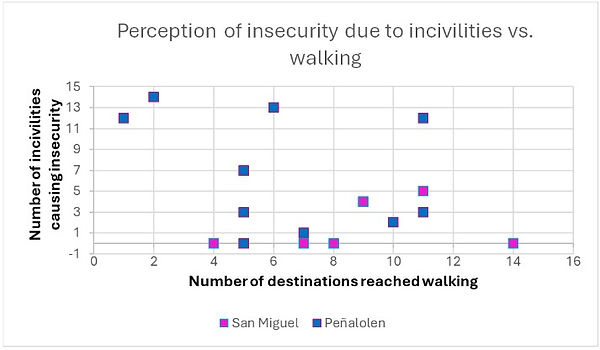
Santiago
In Chile, greater perception of insecurity facing incivilities is observed in the neighborhood of Peñalolen (low crime) and there, too, people walk less. In the high-crime neighborhood, little insecurity is perceived in the face of incivilities and it could be assumed that they are normalized.
Preventive practices
Guadalajara
In Mexico, Colonia Villaseñor (high crime) walks more and develops more preventive practices than Santa Margarita (low crime). There is also less walking in the former than in the latter.
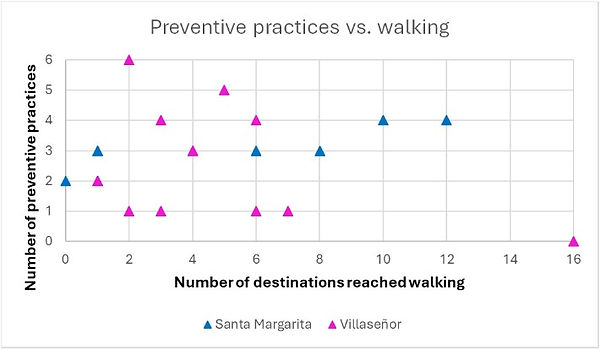
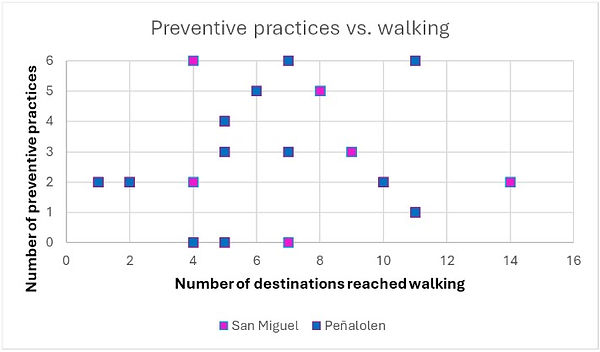
Santiago
In Chile, the San Miguel neighborhood (high crime) develops fewer preventive practices than the Peñaloen neighborhood (low crime). Again, one could think of the normalization of the situation of insecurity in the neighborhood.
Perception of insecurity due to Incivilities and Preventive practices
Placing on the horizontal axis the total number of trips that the person made during the week, and on the vertical axis indicators of perception of insecurity, the trend line appears slightly tilted to the lower right, showing that, indeed, people seem to go out less without being less fearful. But the trend line is insignificant (r2='.06). And when the perception of incivilities is placed on the vertical axis, the data show even less or no correlation. In other words, the link between perception of insecurity and walking in the neighborhood is unclear, as the former does not seem to affect the latter, at least in a direct and forceful way.
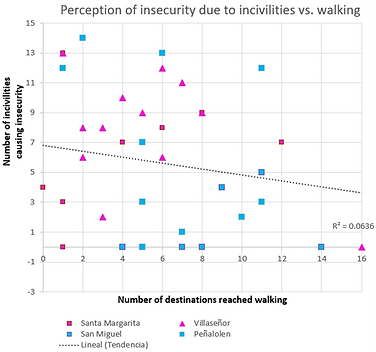
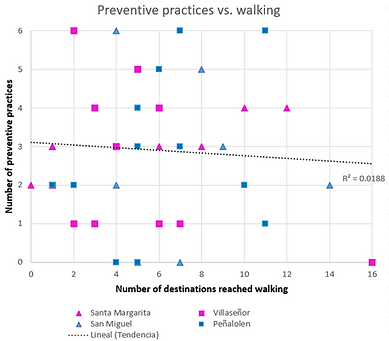
2. Fieldwork: walking practices and perceptions
The walk-through interviews were conducted with groups of between 5 and 6 elderly people in two neighborhoods in both cities according to the criteria described above, carrying out a collective walk on a weekday.
At the time of the conversation roundtable, the topic of insecurity, crime and delinquency was initially avoided, hoping that it would emerge naturally. In the course of the conversation, insecurity gradually came to the surface, and towards the end, more incisive and direct questions were asked about crime.
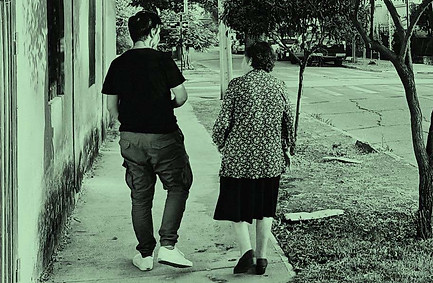
“The third data collection instrument shows, on the other hand, results that give clues of an influence on the walking of older adults, but of a qualitative order, perhaps pointing to a need to reformulate the initial research question. The testimonies derived from the participatory dynamics of the walking interviews reveal a fearful walking experience, which requires a high degree of alertness, with an impact on behaviors up to the point of altering the trajectory of the walk. The coding with Atlas Ti reached 85 significant citations, registering four codes the highest incidence number, being: a) Concern about insecurity (39); b) Fear (30); c) Uncivilities (18) and; d) Neighbors (9).”
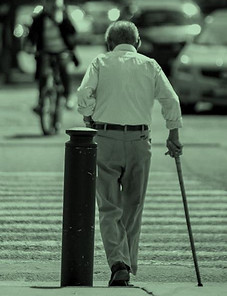
In general terms, the responses can be grouped into two major codes, each with thematic subgroups as follows:
(a)Impact of Crime: Concern and Fear.
b) Incivilities
d)Community
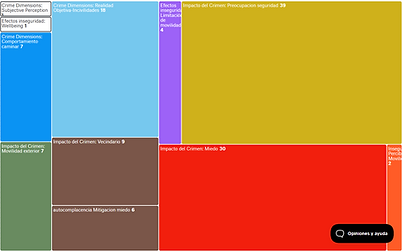
a) Impact of Crime: Concern and Fear
The worry of insecurity when going for a walk is continuously present, leading to a continuous state of alertness:
- Concern and Fear…
“When I'm walking on the sidewalk and I see, at a distance, that a bad guy is coming, that's when I get scared, but I start to pray”.
“Well, because we are more vulnerable than the young” ‘More sensitive’ ‘They can knock us down with a blow’."
“Whenever I walk, I like to keep an eye out to see if they are coming, if they are following me, and to watch out so I don't fall.
Villaseñor
Peñalolen
Sta. Margarita
Guadalajara
- Concern and Fear…
“One day he was coming out of the hairdresser's [...] He stops, slows down, and so a gun goes down to the rooster. He gets ot and they put the gun to the owner's head. [...] So that scares you.”
“For me, because it scares me a little bit at night. Because the square is a bit complicated at night.”
Peñalolen
San Miguel
Santiago
b) Incivilities
In the conversation rounds after the tour, there was a high number of mentions related to cultural practices and evidence of them mentioned, being the third code with the highest incidence of citations. Within these, a deteriorated urban environment is described, with streets full of “stuck cables, hanging cables that are everywhere”, “garbage is everywhere” or “it is the city of garbage”.
Cultural practices are also mentioned, where there are moments that scare away older people because there is “very loud music at late hours”. Additionally, a lack of courtesy on the roads is mentioned, but above all in the street, where there is no recognition of their vulnerability:
- Incivilities…
“[at the corner] even if the vehicle that is high, hope that it does not come” ”are counted, those who give way. ".
Villaseñor
Guadalajara
- Incivilities…
“young people used to respect more than they do now” ‘they don't respect anything anymore’ ‘For example, they're going to pass, when we went, it was full of young people’."
“because of the quality of the people, from another sector” ‘And on what basis do you know that they are from another sector?’ ”Well, you can tell, we know them here and you can see that they are not young people from here."
Peñalolen
Santiago
d) Community and natural surveillance
The above points to a need to socialize with people they know, with whom they already have references, and this is what generates tranquility and the perception of insecurity is lower, even when the person has criminal behavior, the previous knowledge prevents them from being worried:
- Community…
“I don't talk about drunks and addicts, because my block is purely about that. .... I don't feel sorry for them, because they are known. They are known, I have known them since they were kids. Maybe in some other place, well, I would be afraid...”
Villaseñor
“mejoró porque toda la gente se unió y entonces ya pusieron remedio. Agarrar todo el maleante y dejarlo en un lugar y ya se acabó todo.”
Sta. Margarita
Guadalajara
- Community…
“how is it good to have them to trust? For me it's safer to have people on the street (6:28) and get on the street.”
“(16:25) We know the gas company next to the hairdresser's. (16:31) They've been working there for years”.
Peñalolen
Santiago
Next steps and
steps forward
- Identify common perceptions and differences between the two cities
- Relevance of walking, high presence of built environment elements and uses of the public space associated to insecurity, relevance of adaptive strategies
- Do the social features of walking influence mobility decisions more than built environment features?
a) Impact of Crime: Concern and Fear
The worry of insecurity when going for a walk is continuously present, leading to a continuous state of alertness:
- First, public space…
“The rubbish dump is unpleasant to see, as people don't take care of their community”
“The pavement in front is bad to walk on”
- …then, security…
“You know all the young people here. You know who they are. For example, the one who goes there with the bag, that one steals”
“They know us, so that gives you security. The neighbour is always standing there, watching”.
…and adaptations of
mobility practices
“I think it depends on the day and the time. What happens is that you can't pass here on any given day”;
“It's just that you don't come here late at night. At 6 o'clock in the evening you can walk around here”.